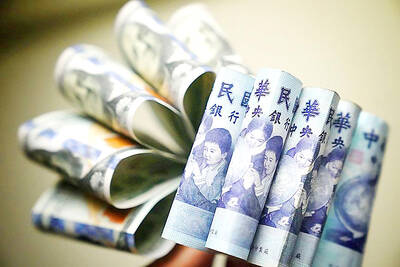Nearly 90 percent of drowning or near-drowning accidents happen to people who know how to swim, Yunlin Elementary School principal Wei Gho-shein (魏國賢) said yesterday.
Apart from not warming up properly, the main reasons that people drown or almost drown are because they have too much confidence in their physical abilities and do not know how to rescue themselves or others, he said.
People who do not know how to swim are afraid of water and are unlikely to approach it on their own, so the chances of something happening to them are lower, he said.

Photo: Chan Shih-hung, Taipei Times
Wei chairs the executive committee of a government-affiliated association for promoting physical education at elementary schools in Yunlin County, which yesterday hosted a lesson on rescuing oneself and others from drowning.
People who take part in water sports and activities must do so in a safe place with a lifeguard, Wei said.
Swimmers should warm up before entering the water and avoid wearing jeans, engaging in dangerous behavior or diving, he said.
They should not swim alone and should always pay attention to where their friends are, Wei said, adding that being submerged in water for too long can cause hypothermia.
Improving one’s swimming and floating techniques could be of benefit, and if an accident does occur, people should stay calm, he said.
Water-based sports and activities are a popular choice for beating the heat during the summer, but people often do not pay attention to their safety, said Lin Yueh-chang (林岳璋), captain of the water rescue team at the Red Cross Society’s Yunlin branch.
People should immediately call 119 if they see someone drowning, Lin said.
They should try to reach for the person with a pole, branch or other item, and if that does not work they should throw a ball, bottle or anything that floats toward them, then swim to them with a life vest, Styrofoam float or other floatation device, he said.

A magnitude 6.4 earthquake struck off the coast of Hualien County in eastern Taiwan at 7pm yesterday, the Central Weather Administration (CWA) said. The epicenter of the temblor was at sea, about 69.9km south of Hualien County Hall, at a depth of 30.9km, it said. There were no immediate reports of damage resulting from the quake. The earthquake’s intensity, which gauges the actual effect of a temblor, was highest in Taitung County’s Changbin Township (長濱), where it measured 5 on Taiwan’s seven-tier intensity scale. The quake also measured an intensity of 4 in Hualien, Nantou, Chiayi, Yunlin, Changhua and Miaoli counties, as well as

Credit departments of farmers’ and fishers’ associations blocked a total of more than NT$180 million (US$6.01 million) from being lost to scams last year, National Police Agency (NPA) data showed. The Agricultural Finance Agency (AFA) said last week that staff of farmers’ and fishers’ associations’ credit departments are required to implement fraud prevention measures when they serve clients at the counter. They would ask clients about personal financial management activities whenever they suspect there might be a fraud situation, and would immediately report the incident to local authorities, which would send police officers to the site to help, it said. NPA data showed

ENERGY RESILIENCE: Although Alaska is open for investments, Taiwan is sourcing its gas from the Middle East, and the sea routes carry risks, Ho Cheng-hui said US government officials’ high-profile reception of a Taiwanese representative at the Alaska Sustainable Energy Conference indicated the emergence of an Indo-Pacific energy resilience alliance, an academic said. Presidential Office Secretary-General Pan Men-an (潘孟安) attended the conference in Alaska on Thursday last week at the invitation of the US government. Pan visited oil and gas facilities with senior US officials, including US Secretary of the Interior Doug Burgum, US Secretary of Energy Chris Wright, Alaska Governor Mike Dunleavy and US Senator Daniel Sullivan. Pan attending the conference on behalf of President William Lai (賴清德) shows a significant elevation in diplomatic representation,

The Taipei City Reserve Command yesterday initiated its first-ever 14-day recall of some of the city’s civilian service reservists, who are to undergo additional training on top of refresher courses. The command said that it rented sites in Neihu District (內湖), including the Taipei Tennis Center, for the duration of the camp to optimize tactical positioning and accommodate the size of the battalion of reservists. A battalion is made up of four companies of more than 200 reservists each, it said. Aside from shooting drills at a range in New Taipei City’s Linkou District (林口), the remainder of the training would be at